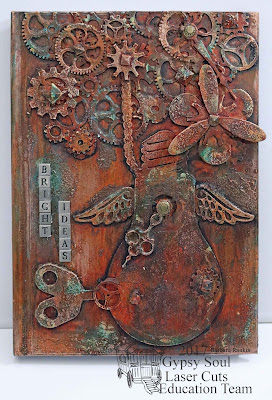Here is what I mean. Instead of starting with that scary, blank white canvas, just choose some chipboard you think you might use and start laying out the pieces. Voila! No more scary, blank white canvas. Now I have my jumping off point.
Next, I adhered my chipboard to the canvas and then gave it a quick coat of white gesso. The little bird on the cage has not been adhered yet, only gessoed. I may need to change my mind about placement. Let gesso dry.
Place canvas inside a box to catch the extra spray from the misters. Use ColourArte Shimmering Mists to add color to background, as follows:
Bashful Blue
Teal Zircon - Upper Half of Canvas
Fern - Lower Half of Canvas
Seafoam - lower half
More Bashful Blue - upper half
More Fern - lower half
Even More Fern - Lower half
Mists dried naturally
Tree branch - Burnt Umber H20
Leaves - Rainforest H20
Birds - Beachouse Blue H20
Bird Cage - Ancient Coin H20
Leaves - Key Lime H20, let dry, add Crazing Collage Medium
Bird Cage - Bronze H20
Birds - Water H20
Spritz background with water, manipulate colors with brush
Bird Cage - Patina Gilding Wax
Add shading beneath branches, leaves, birds, and bird cage with charcoal pencil and smudge with finger or blending stump
Closeup of patina gilding wax
Glue standing bird to front of bird cage
Computer generate the quote using a font of your choice onto parchment card stock. Here is the actual quote I got my wording from.
“The reason birds can fly and we can't is simply because they have perfect faith, for to have faith is to have wings.”
― J.M. Barrie, The Little White Bird
Adhere card stock to slightly larger black chipboard that has been painted with the Ancient Coin and Bronze Twinkling H20s ...
Use a stencil brush to add a light brick background with Moss gilding wax through brick stencil.
Edge canvas with Black Gold gilding wax and the same stencil brush. Blend wax out with your fingers, if necessary.
Finish off canvas with flowers and leaves around the bird cage, and a butterfly just above the cage.
And a few closeups from different angles. I really love the dimension from the chipboard.
Supplies Used:
GSL Birds Shape Set
GSL Doodled Cage with Solid Back
GSL Leafy Branches with Birds (contact store)
ColourArte Radiant Rains Shimmering Mists
Bashful Blue
Teal Zircon
Fern
Seafoam
ColourArte Twinkling H20s
Key Lime
Rainforest
Raspberry Wine
Ancient Coin
Bronze
Burnt Umber
Beachouse Blue
Tim Holtz Brick Stencil
Miss Lillian's Gilding Paste (Moss, Black Gold, Patina)
White gesso
Thanks so much for stopping by, and I hope you feel inspired to make your very own chipboard embellished mixed media canvas.
Have a wonderful day, and remember to take time to play!
Barbara
























































